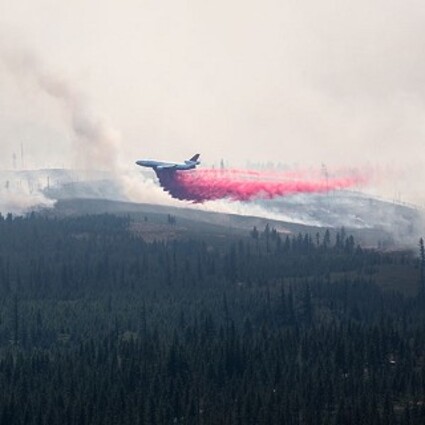What air power can - and can't - do on a fire
Last updated 8/21/2017 at Noon

Cody Rheault
An air tanker makes a retardant drop to slow the progress of the Milli Fire west of Sisters.
There's no more impressive sight than a heavy tanker swooping out of the smoke over a forest fire, dropping a vivid red smear of retardant. For local residents, it's comforting to hear the tankers rumbling over the rooftops to do battle with the smoky monster that looms on the horizon over their town.
The sheer power and majesty of the aerial assault leads many people to believe that retardant drops can stop a raging blaze. While air power is critical to the battle, it can't win it on its own.
The key to understanding the role of retardant drops on a fire lies in the word itself: Retardant retards the progress of fire - it doesn't put it out.
Sisters Ranger District Assistant Fire Management Officer Jinny Reed told The Nugget that, "Retardant is primarily utilized when life and property are threatened. Retardant can slow fire progression to allow ground resources the opportunity to safely contain the progression of a wildfire along the fires edge, and sometimes at the head. If applied properly, it can reduce fire intensity to a level acceptable for dozers and handcrews to contain forward spread."
That's why viewers will often see that smear of retardant going down out ahead of the fire instead of right in it. The retardant is being used by ground forces to help them build containment lines.
"Aerial retardant is only effective when utilized in tandem with ground forces such as dozers and handcrews," Reed said.
In fact, retardant drops won't be made if there aren't ground resources available to exploit them.
Retardant drops work better in some terrain than in others.
"It is most effective in grass and shrub vegetation types," Reed reported. "Retardant is less effective in timber vegetation types."
Tankers are not always available. There are a limited number of them across the country and they're allocated based on a priorty system that assesses threats to lives and property. Sometimes tankers working a fire in Sisters Country will be called away to a higher-priority fire.
Fire conditions can also dictate whether or not retardant can be used.
"Retardant cannot be utilized if visibility is poor (or) during high winds," Reed said.
So, while retardant drops from tankers are a critical - and spectacular - tool for firefighters, the battle is not won in the air. It's fought out on the ground, by the men and women hauling hose, wielding chainsaws and cutting on a firebreak line.
Retardant drops can also have negative environmental effects, so air operations commanders have to be cautious about their deployment in sensitive areas.
Kassidy Kern of the Deschutes National Forest reported that a retardant drop deployed near the rim of Whychus Creek Canyon to fight the Milli Fire as it roared toward the east probably came in a second or two early."
As a result, she said, "up to 140 gallons of retardant probably made its way into Whychus Creek."
She said that a fisheries biologist patrolled the area to assess damage and found no fish kill or other adverse effects.

















Reader Comments(0)